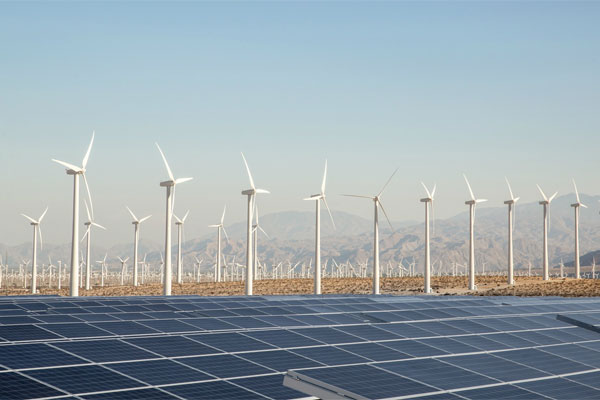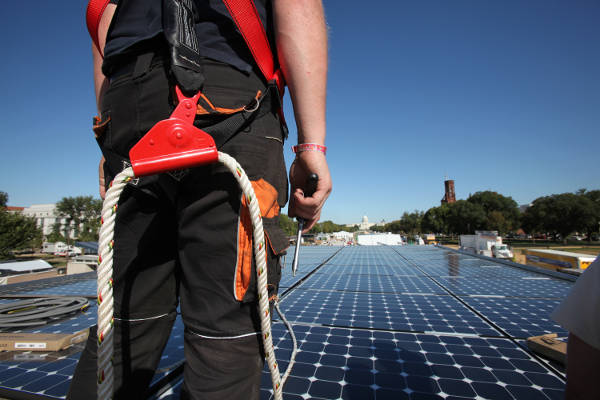According to a review by the SUN DAY Campaign of data just released by the Federal Energy Regulatory Commission (FERC), wind, solar, and hydropower provided 100% of the 1,328 megawatts (MW) in new U.S. electrical generating capacity added in April 2020.
FERC’s latest monthly “Energy Infrastructure Update” report (with data through April 30, 2020) also reveals that renewable energy sources (i.e., biomass, geothermal, hydropower, solar, wind) have accounted for 5,113 MW – or 56.3% – of the 9,082 MW added during the first four months of this year.
Thirty-two new “units” of wind (totaling 3,104 MW) were added to the U.S.’s total energy generating capacity accompanied by 110 units of solar (1,973 MW), six units of hydropower (25 MW), and two units of biomass (11 MW).
FERC also reported 3,964 MW (or 21 units) of new natural gas capacity, which accounted for most of the balance. There have been no new capacity additions by coal, oil, nuclear power, or geothermal energy since the beginning of the year.
Renewable energy sources now account for 22.87% of the nation’s total available installed generating capacity and continue to expand their lead over coal (20.32%). [1] The generating capacity of just wind and solar is now at 12.87% of the nation’s total … and that does not include distributed (e.g., rooftop) solar. [2]
For perspective, five years ago, FERC reported that total installed renewable energy generating capacity was 17.05% of the nation’s total with wind at 5.74% (now 9.08%) and solar at 1.05% (now 3.79%). Thus, over the past half-decade, wind’s share of the nation’s generating capacity has nearly doubled while that of solar is now almost four times greater.
By comparison, in April 2015, coal’s share was 27.50% (now 20.32%), nuclear was 9.14% (now 8.71%), and oil was 3.92% (now 3.29%). Only natural gas has shown any growth among non-renewable sources – expanding from a 42.23% share five years ago to 44.64% today.
In addition, FERC data suggest that renewables’ share of generating capacity should increase significantly over the next three years (i.e., by April 2023). “High probability” generation capacity additions for wind, minus anticipated retirements, reflect a projected net increase of 26,867 MW while solar is foreseen growing by 24,083 MW. By comparison, net growth for natural gas will be only 20,657 MW. Thus, wind and solar are on track to each provide more new generating capacity than natural gas over the next three years.
While hydropower, geothermal, and biomass also are all projected to experience net growth (1,903 MW, 178 MW, and 19 MW respectively), the generating capacity of coal and oil are projected to plummet – by 16,428 MW and 3,112 MW respectively. In fact, FERC reports no new coal capacity in the pipeline over the next three years and just 4 MW of new oil-based capacity. Nuclear power is forecast to remain essentially unchanged – adding just 2 MW.
In total, the mix of all renewables will add more than 53 gigawatts (GW) of net new generating capacity to the nation’s total by April 2023. That is nearly 50 times the net new capacity (1.1 GW) projected to be added by natural gas, coal, oil, and nuclear power combined.
If these numbers hold, over the next three years, renewable energy generating capacity should account for more than a quarter of the nation’s total available installed generating capacity.
In fact, renewables’ share could be even higher. Over the past year, FERC has been regularly increasing its renewable energy projections in its monthly “Infrastructure” reports. For example, two months ago in its February report, FERC forecast net growth over the next three years of 50,933 MW for renewable energy sources – i.e., 2,117 MW less than its latest projection.
“Notwithstanding the impacts of the global coronavirus crisis, renewables – especially wind and solar – are continuing on their march to eventual energy dominance,” noted Ken Bossong, Executive Director of the SUN DAY Campaign. “And as prices for renewably-generated electricity fall ever-lower, that growth trend seems certain to accelerate.”













Comments